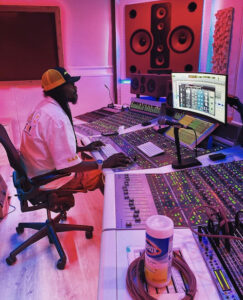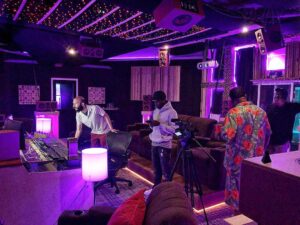Your music cover is not just an element of decoration; it is a symbol that speaks for itself, speaks for you, and your brand. It is the first impression of your music, a visual teaser that attracts your listeners before even hearing a single track.
A music album cover is important, especially in today’s saturated world, to grab someone’s attention. But with so many creative options to build your cover, it is very difficult to choose a perfect album cover, especially where everyone has access to music studios in Atlanta Georgia. So, here is a blog that will help you find what will best suit your music.
1. Understanding Your Music Identity:
Before starting anything else with any recording studios Atlanta, you need to understand your music properly. This includes everything from your music theme to the emotions it conveys to the audience. Ask the following questions of yourself:
- What theme is your song based on?
- What emotions are you looking to drive from your audience through your soundtracks?
- Is your song raw, gritty, polished, and clean?
- Does your song angle towards any specific genre; hip hop, rock, indie, classical twist, or pop?
Find answers to these basic questions. Answering these questions will help you make informed choices. For instance, if your music is melancholic acoustic, then the best cover you can find for it is a desaturated, minimalist cover. Whereas, if it’s an upbeat dance album, it may use vibrant colors and dynamic shapes.

( Also Read More – Why Does a Song Need to Be Mastered? )
2. Know Your Target Audience:
It is very important to know who your target audience is; for whom are you planning to create this album? Your music album cover needs to meet your audience’s expectations. For instance, if your audience is teen pop listeners, they might prefer something bold and eye-catching visuals. Whereas, if you are making music for old jazz listeners, they might feel drawn to the refined, elegant designs.
Demographics and psychographics are also quite important. You need to understand where your audience belongs and what kind of music they will be interested in. You need to understand their values and lifestyle too.
If your target audience is Gen Z, then trends like vaporwave aesthetics or nostalgic early 2000s looks might appeal to them. Meanwhile, millennials will be drawn towards a more mature audience that might appreciate subtlety and sophistication.
3. Align Your Brand Aesthetics:
Every artist makes a brand, knowingly or unknowingly and your music album is what makes or breaks your personal as well as professional brand. So, it is important to add your initials to your album. Think about:
- Your Logo.
- Social Media Visuals.
- Previous Album or Single Covers.
- Merchandise Designs.
Your branding needs to be consistent. Consistency builds recognition! If people know your songs for your dreamy visuals with pastel tones, make sure you don’t suddenly change the visuals to a gothic horror theme unless your PR team’s part of a deliberate rebranding.
( Read More – How to Maintain a Consistent Studio Practice )
4. Get Inspired By Music:
Sometimes you get inspiration from your own songs, so listen to your album multiple times (as many times as you want). And visualize imagery, colors, or moods that emerge from the emotions.
Ask yourself the following questions:
- Is there a need for a recurring motif or lyric that can be illustrated?
- Does a specific soundtrack summarize the whole vibe of your album?
- Are you able to depict a metaphor from your lyrics visually?
Let your music speak. Great albums are nothing but a depiction of a feeling you convey through your songs.
5. Decide On Your Artistic Style:
When we speak about the style, you can put it on your album cover– there are endless possibilities, you can choose from.
- Photography:
You can put a candid or even staged photograph as your album cover. It can be a realistic image, or you can choose to put an abstract one too.
- Illustrations:
It can be hand-drawn, digital, or mixed media.
- Typography-based:
You can also focus preferably on different fonts and layouts.
- Graphic Design:
One of the most commonly used covers that focuses specifically on geometric, modern, layered covers.
- College:
A blend of different textures, photos, and elements.
Choose any of the styles that perfectly resonate with your music’s mood. You can also mix two or more together. A lo-fi hip-hop artist might use some grainy film photography or doodle-style drawings. Whereas, if you are an electronic music producer, you might like to stick to a sleek, futuristic 3D render.
(Also Read About – Sound Engineer’s Daily Grinding at Soul Asylum Studios)
6. Consider The Medium and Format:
The question is, where will your music album be seen most?
- Digital platforms like Spotify, Apple Music, or YouTube?
- On Vinyl Records?
- On Physical CDs?
The medium that your music album will use says a lot about how your album cover should look. If it is a digital platform, which usually showcases your album art in small sizes, then simplicity and clarity matter. However, bold elements and minimal text look better and eye-catching on thumbnails of YouTube.
Whereas, vinyl records showcase your music album with more detail and bigger visual storytelling. For physical formats, make sure that your spine and back cover designs are cohesive and bold. For professional assistance, you should contact music studios Atlanta.
7. Collaborate With the Right Designer and Artists:
It is better if you have knowledge, but don’t worry if you are not a visual artist. You can easily collaborate with someone more experienced in the field. A skilled and experienced designer will get to know your vision and elevate it in the best way possible. Whether you’re working with any music studios, having the right visual representation is crucial.
How to find a visual artist?
- Look for artists with a portfolio that matches your vision.
- Share your music and your ideas for the mood, themes, and references.
- Make sure you are open to feedback and let them interpret the sound visually.
Many artists who work with music studios in Atlanta Georgia understand the local music scene and can provide valuable insights for your album artwork.

( Also Read about – Introduction to the Soul Asylum Studios )
8. Use Color Psychology:
Colors translate emotions. If you use the color theory strategically, you can improve the message that your music narrates.
Let’s know what colors evoke which emotions:
- Red: Passion, danger, energy.
- Blue: Calm, sadness, introspection.
- Yellow: Joy, optimism, energy.
- Black and White: Contrast, minimalism, vintage.
- Pastels: Softness, nostalgia, innocence.
Pick the most appropriate color that matches the vibe and tone of your music. Make sure there is good contrast between the elements so it’s easy to recognize.
Conclusion:
Choosing the perfect music album cover is not just about the design. Rather, it is creative art that speaks your musical expressions. By aligning your visuals with your song, your audience, and your brand, you can create a cover that will not just attract listeners. But it will also become an iconic symbol of your work. Whether you’re working with recording studios in Atlanta or need space for creative photoshoots like Atlanta dance studio rental. The right environment can inspire your visual direction. Once you are done, you will realise you have not just created a cover, but gained an experience.

